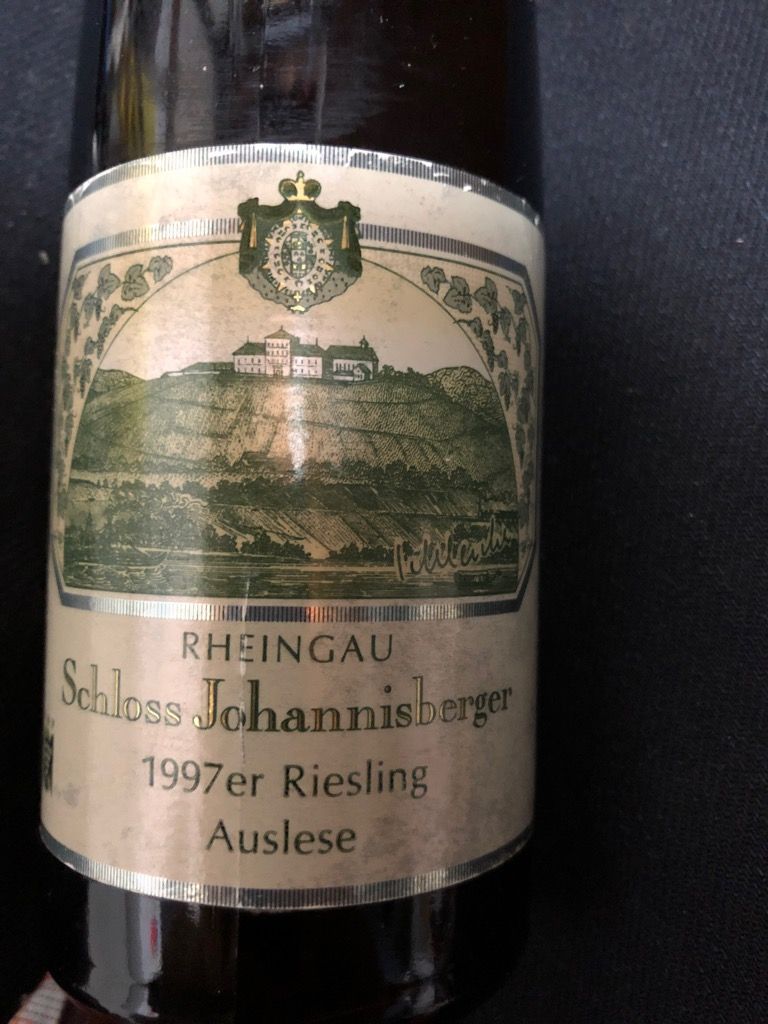
External search
Google (images)
Wine Advocate
Wine Spectator
Burghound
Wine-Searcher
Vintages
2020
2019
2018
2016
2015
1997
From this producer
Show all wines
All tasting notes
|
| Drinking Windows and Values |
| Drinking window: Drink between 1998 and 2078 (based on 1 user opinion) |
| Community Tasting History |
| Schloss Johannisberg Producer website
U.S. Importer
A note on this producer and its naming/labeling convention. From: http://www.schloss-johannisberg.de/en/johannisberger.htm
The Key to the Colors
Various colors have been used to distinguish wine qualities at Schloss Johannisberg since the days of Fürst von Metternich. Then (1820), with “Siegellack” (wax seals); today, with colored capsules:
Gelblack (yellow seal): QbA
Rotlack (red seal): Kabinett
Grünlack (green seal): Spätlese
Silberlack (silver seal): 1.Gewächs (first growth)
Rosalack (pink seal): Auslese
Rosa-Goldlack (pink-gold seal): Beerenauslese
Goldlack (gold seal): Trockenbeerenauslese
Blaulack (blue seal): Eiswein
Lagenbeschreibung:
Die Lage Schloß Johannisberger ist im Monopolbesitz der Weinbau-Domäne Schloß Johannisberg. Der 50. Breitengrad verläuft direkt durch den vorgelagerten Taunusquarzitfelsen, oberhalb des Rheinlaufs zwischen Oestrich-Winkel und Geisenheim gelegen. Von Norden her wird der Weinberg durch die bewaldeten Taunushöhen gegen kalte Winde geschützt, im Süden liegt der Rhein seenartig am Fuße des Berges. In absoluter Südausrichtung, mit einer Hangneigung von bis zu 45 %, ist die Einzellage auf 114 m bis 182 m ansteigend über NN gelegen. Im östlichen Berg strahlt die Morgensonne ein, während im zentralen und südwestlichen Bereich unserer Rebfläche die intensivste Sonneneinstrahlung messbar ist. Mit rund 1.700 Sonnenstunden im Jahresmittel, weist der Schloss Johannisberger die höchste Energiezufuhr im Rheingau auf. Bereits im Jahre 1143 wurde der Weinberg als „monte sancti Johannis“ in alten Aufzeichnungen erwähnt, nachdem die benediktinische Abtei auf der Anhöhe zu Ehren Johannes dem Täufer geweiht wurde.
Seit 1720 wird hier ausschließlich Riesling angebaut und somit gilt der Johannisberger als weltweit erster geschlossener Weinberg, der mit dieser edlen Rebsorte bestockt ist. Schon im Jahre 1870 wurden die Weine in England bereits mit dem Aufdruck „first growth“ verkauft.
Boden:
Die Bodenformation aus reinem Taunusquarzit mit Auflagen von mittel- bis tiefgründigen Löss-Lehmen speichert Wärme und Wasser in besonders hohem Maße.Riesling Varietal character (Appellation America) | A short history of Riesling (Uncork) | Riesling (wikipedia)Germany Wines of Germany | The Association of German Prädikat Wine Estates (VDP) | How to read a German wine label | Geographical Information Down to Single Vineyards
#2014 Vintage Notes:
2014 Vintage Report by Terry Theise
2014 Vintage Report by Wine Spectator
"My gut still tells me the Saar (and to some extent) the Ruwer are better overall in 2014 than the more storied areas of the Mosel proper, but those that spent the requisite time living in their middle-Mosel vineyards made some of the most electric and "feathery" Riesling in a long time (maybe the finest in 20 years - yes, it's true!)" - Jon Rimmerman (Of course only a very short historical memory would call the Saar and Ruwer less 'storied' than the middle Mosel - jht)Rheingau VDP Rheingau (Official site) | The Rheingau (Wines of Germany) | Wikipedia about The Rheingau
On weinlagen.info
The small but fine wine-growing area Rheingau offers one for the culture of the vine ideal microclimate and best soil conditions. The Rhine runs uninterruptedly almost one thousand kilometres from Basel up to its muzzle into the North Sea, in a northerly direction. With a short exception - the Rheingau. The Rheingau mountains force the river to a change in direction here. The vineyards falling in this region to the south stretch really to the sun. The king of the white wines, the Riesling, finds ideal local conditions for the unfolding of his fine fruity and elegant type of vine character on the multilayered weathering grounds with loess, loam and sand additions. |
|




